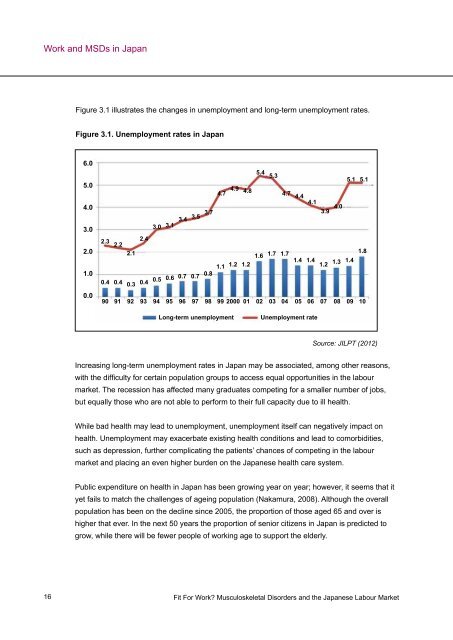English version - Fit for Work Europe
English version - Fit for Work Europe
English version - Fit for Work Europe
You also want an ePaper? Increase the reach of your titles
YUMPU automatically turns print PDFs into web optimized ePapers that Google loves.
<strong>Work</strong> and MSDs in Japan<br />
16<br />
Figure 3.1 illustrates the changes in unemployment and long-term unemployment rates.<br />
Figure 3.1. Unemployment rates in Japan<br />
6.0<br />
5.0<br />
4.0<br />
3.0<br />
2.0<br />
1.0<br />
0.0<br />
2.3 2.2<br />
2.1<br />
2.4<br />
0.4 0.4 0.3 0.4<br />
3.0<br />
3.1 3.4 3.5 3.7<br />
0.5 0.6 0.7 0.7 0.8<br />
4.7 4.9 4.8<br />
1.1<br />
1.2 1.2<br />
5.4 5.3<br />
90 91 92 93 94 95 96 97 98 99 2000 01 02 03 04 05 06 07 08 09 10<br />
1.6<br />
1.7 1.7<br />
4.7 4.4 4.1<br />
Long-term unemployment Unemployment rate<br />
3.9 4.0<br />
1.4 1.4 1.2 1.3 1.4<br />
5.1 5.1<br />
<strong>Fit</strong> For <strong>Work</strong>? Musculoskeletal Disorders and the Japanese Labour Market<br />
1.8<br />
Source: JILPT (2012)<br />
Increasing long-term unemployment rates in Japan may be associated, among other reasons,<br />
with the difficulty <strong>for</strong> certain population groups to access equal opportunities in the labour<br />
market. The recession has affected many graduates competing <strong>for</strong> a smaller number of jobs,<br />
but equally those who are not able to per<strong>for</strong>m to their full capacity due to ill health.<br />
While bad health may lead to unemployment, unemployment itself can negatively impact on<br />
health. Unemployment may exacerbate existing health conditions and lead to comorbidities,<br />
such as depression, further complicating the patients’ chances of competing in the labour<br />
market and placing an even higher burden on the Japanese health care system.<br />
Public expenditure on health in Japan has been growing year on year; however, it seems that it<br />
yet fails to match the challenges of ageing population (Nakamura, 2008). Although the overall<br />
population has been on the decline since 2005, the proportion of those aged 65 and over is<br />
higher that ever. In the next 50 years the proportion of senior citizens in Japan is predicted to<br />
grow, while there will be fewer people of working age to support the elderly.







